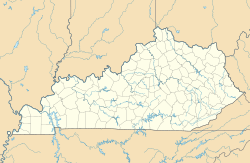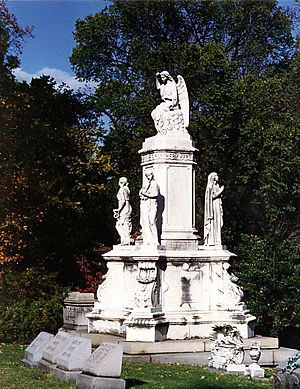Cave Hill Cemetery facts for kids
Quick facts for kids |
|
|
Cave Hill Cemetery
|
|
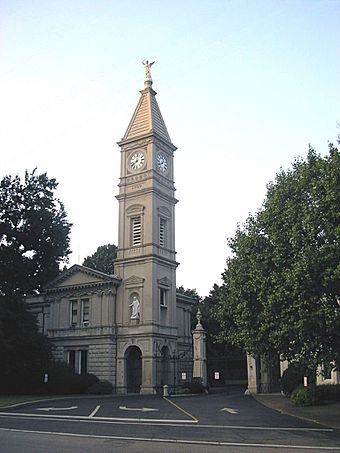
Main entrance on Baxter Avenue
|
|
| Location | 701 Baxter Avenue, Louisville, Kentucky |
|---|---|
| Area | 296 acres (1.20 km2) |
| Built | 1848–1913 |
| Architectural style | Corinthian, Victorian |
| NRHP reference No. | 79000999 |
| Added to NRHP | 1979 |
Cave Hill Cemetery is a large, beautiful cemetery and arboretum (a place with many different kinds of trees) in Louisville, Kentucky, United States. It covers about 296 acres, which is like 225 football fields! It's known for its old-fashioned, grand Victorian era style.
The cemetery is also a National Cemetery, meaning it has graves for military members. It's the biggest cemetery in Louisville by size and the number of people buried there. You can find its main entrance on Baxter Avenue.
Cave Hill was added to the National Register of Historic Places in 1979 because of its historical importance. The part of the cemetery where military members are buried, called Cave Hill National Cemetery, was added to the Register in 1998.
Contents
History of Cave Hill
Cave Hill Cemetery started in 1848 on what used to be William Johnston's farm. Back then, it was a quiet, rural area far from Louisville. In the 1830s, city leaders bought some of this land, thinking they would build a railroad there.
In 1846, the mayor, Frederick A. Kaye, thought about creating a "garden-style" cemetery. This was a popular idea at the time. These cemeteries were designed to be peaceful, park-like places. Edmund Francis Lee, a civil engineer, planned the cemetery with winding paths, graves on hills, and lakes in the valleys.
The Cave Hill Cemetery Company was officially started in February 1848. The cemetery opened on July 25, 1848. Reverend Doctor Edward Porter Humphrey gave a speech, talking about how the cemetery should be a beautiful place.
Before big city parks existed, cemeteries like Cave Hill were often used as green spaces where people could relax and enjoy nature. This changed when Cherokee Park opened nearby in 1892.
During the American Civil War, administrators sold land for the burial of Union soldiers. Later, supporters of the Confederacy bought nearby land for their soldiers. Many soldiers who died in local army hospitals were buried here.
The original farmhouse on the property was used as a hospital for sick people and was torn down in 1872. A new building, Beechhurst Sanitarium, was built nearby in 1872 but was also taken down in 1936.
The main entrance gates and a small building called the entrance lodge were designed in 1880 by architect William H. Reddin. They have a grand Italian Renaissance Revival style.
The cemetery grew to its current size of almost 300 acres in 1888. In the 1980s, special fencing was added to the brick walls to keep people from entering after hours.
A special viewing spot called Twin Lakes Scenic Overlook opened on August 20, 2008.
Buildings and Natural Features
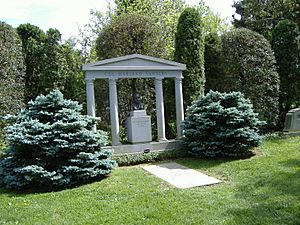
The main entrance on Baxter Avenue, which the cemetery calls the Broadway Entrance, was finished in 1892. This grand building has a Corinthian-style design and a clock tower with a 2000-pound bell. The tower used to be the tallest building around and was often hit by lightning! It was last fixed up in 2001. Another entrance on Grinstead Drive was built in 1913.
There are also other buildings, like a stone office building near a lake and a Rustic Shelter House built in 1892.
The cemetery has monuments and graves for three Union generals. The 32nd Indiana Monument, also known as the "August Bloedner Monument," is so important that it's listed separately on the National Register.
A part of Beargrass Creek flows through Cave Hill. A stream that feeds into the creek divides the cemetery into older (western) and newer (eastern) parts. This stream comes from a spring near the cave that gave the property its name. You can go into the cave for about 30 feet, but it's officially off-limits. There are also five man-made lakes in the cemetery.
Cave Hill is famous as an arboretum. It has more than 500 types of trees and shrubs! This includes native trees like pignut hickory and unique trees from other parts of the world, like Caucasian wingnut.
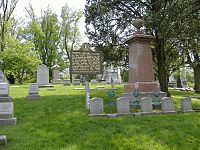
Famous People Buried Here
By 2002, about 120,000 people were buried at Cave Hill. There's still space for about 22,000 more graves. Many important people are buried here.
One very famous person is George Rogers Clark (1752-1818). He was a military officer during the American Revolutionary War and helped found Louisville.
More than 200 Confederate soldiers are buried in a special section of the cemetery. Many of their original wooden markers were replaced with stone ones in 1880–1881. Some markers are for unknown soldiers. One Confederate general, Alpheus Baker, is buried here, along with two other Confederate generals in different parts of the cemetery. The Confederate flag flies over this area.
In another section for U.S. Soldiers, there is one grave for a British soldier who died in 1918. He was part of the British Military Mission to the United States.
Other notable people buried at Cave Hill include:
- Mary Ann Xantippe "Tip" Saunders, a portrait painter and cousin of Mark Twain.
- Patty Hill and Mildred J. Hill, sisters who wrote the famous "Happy Birthday" song.
- Muhammad Ali, the legendary boxing champion who was born in Louisville. He was buried here on June 10, 2016.
- Colonel Harland Sanders, the founder of Kentucky Fried Chicken.
- Mia Zapata, the lead singer of the punk band The Gits.
- Paul Hornung, a famous football player who won the Heisman Trophy and played for the Green Bay Packers. He was buried in 2020.
Gallery
-
Plaque quoting the poem "Bivouac of the Dead"
-
George Rogers Clark gravestone
Images for kids


